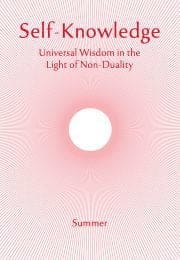The Brihadaranyaka Upanishad
The Brihadaranyaka is the longest of the Upanishads and provides an in-depth account of how one’s innermost Self is identical with the Absolute as the one and only reality. Overarching the whole text with its three hundred-plus verses is the question: What is the nature of that knowledge which replaces our sense of individuality with the realisation that one is the All? In the words of the Upanishad:
Through the knowledge of Brahman we shall become all. Well, what did that Brahman know by which it became all? (1:4:9)
And the Upanishad goes on:
This (self) was indeed Brahman in the beginning. It knew only itself as ‘I am Brahman’. Therefore it became all...
And to this day whoever in like manner knows it as ‘I am Brahman’ becomes all this (universe). (from 1:4:10)
There is therefore a certain kind of knowledge that is different, that is not so much to be known as to be realised. The word ‘realised’ yields a hint that this knowledge is already with us, but somehow is overlooked, not recognised for what it is.
The issue here is momentous, concerning human purpose and destiny, and our place in the universe—or should we say, the universe’s place in us? The question is abstruse, and its resolution is not through reasoning, but by realisation of what is true in experience, and always has been the ultimate truth. Therefore when the verse uses the expression ‘in the beginning’, it is not a reference to the first day of the universe. ‘In the beginning’ means the true situation—the real nature of experience as it stands eternally. Truth will be revealed as it is, once all wrong ideas have been negated in the light of true knowledge. The question remains: ‘What kind of knowledge is that?’
Although this mystery of the true nature of experience—how we regard the All—cannot be fathomed by reasoning, nothing is more reasonable than the practical methods prescribed in the Upanishad to help us make progress in this inward-looking quest. For it is in this Upanishad that we are introduced to the technique for assimilating the teaching, and bringing it to life within us. This is the process known as shravana, manana and nididhyasana:
The Self, my dear Maitreyi, should be realised: should be heard of (shravana), reflected on (manana) and meditated upon (nididhyasana)... [Through these means] all this is known. (2:4:5)
The subject of our present enquiry is the knowledge of Brahman, the All, and this calls for a special kind of approach and under-standing if it is to lead to an awakening. Our listening needs to be free from preconceived ideas about the subject, however much we may have studied it up to now. Such a mind is like an empty cup, a purely receptive vessel, free from admixture or diversion caused by our habitual ways of thought.
Our listening has to be followed by deep, critical reflection on what has been heard and received. This means actively considering how far we have understood and assimilated the key points. It is this voluntary brooding on the teachings that will bring them to life within us. Our wish and will to fathom their meaning is thus constantly present in our thoughts.
The third stage of the process, nididhyasana, means continuous, undisturbed meditation on a single idea related to the principle of non-duality. This comes about either when manana matures into an intuitive certainty and recognition of the unchanging principle, or, in the early stages, during the special time dedicated to meditation practice, when, by an act of will, discursive thinking is restrained and the attention is held in one-pointed focus on the text or symbol that has been chosen for meditation.
The sage who appears in the role of the teacher in the Brihadaranyaka Upanishad is Yajnavalkya, a name well-known as an authority in all matters concerning the religious life of the day, as well as matters that transcend convention and shed light on what lies beyond appearances and rituals. When he says ‘my dear Maitreyi’, he is addressing his wife, who is herself a seeker of eternal truth. It is worth mentioning that such references to ‘real people’ are rare in the Upanishads, where narrative, when used, is often mythological, the chief players being drawn from the gods, rather than humans. For example, in the Katha Upanishad the expounder is Yama, the god of death, and in the Chandogya, we find Prajapati, king of the gods, teaching the equally mythological figures, Indra and Virochana. But in our present study, Yajnavalkya is depicted as very much a real character, now an elderly man, having life-like interchanges with other characters, and not lacking in a sense of humour.
On this occasion, Maitreyi is taught that the ultimate object of our love is our own true self, and that other people and things are valued insofar as their existence and proximity relate to ourselves.
It is not for the sake of the husband that he is loved, but for one’s own sake that he is loved....
It is not for the sake of the sons that they are loved, but for one’s own sake that they are loved...(2:4:5)
This is saying that what we really love is always our self. In our unillumined stages we identify with our mind and body and ‘love’ that which serves their interests. When we come to identify our Self as the unchanging principle of being-consciousness, then we recognise the same Self in all, and this is the deeper meaning of love. Yajnavalkya’s teaching conveys the essential point that at all stages, what we love is what we identify with as our Self. Therefore one should track down one’s true Self as the source of all attraction and sense of dearness.
Subscribe or enrol for free guest access to read all of this article and Self-Knowledge online.
Already subscribed or enrolled? Log in:


